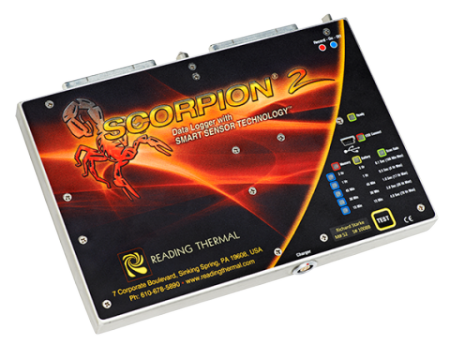To bake your products to perfection, it’s important to know what is happening inside your commercial bakery oven. Optimizing oven conditions is easier when you are using thermal profiling equipment from Reading Thermal.
Reading Thermal, headquartered in Sinking Spring, Pennsylvania, has been studying, measuring, and understanding the commercial baking process for more than 25 years. We manufacture and support the SCORPION® 2 Data Logger, which measures and maps the key baking parameters of temperature, air velocity, heat flux and humidity, and has become a standard in the baking industry.
By connecting different smart sensors and sensor arrays to the SCORPION® 2 Data Logger and passing them through the oven with the product, the measurement system captures the four main baking parameters:
1) Temperature: Oven temperature causes physical and chemical reactions in dough/batter. Insufficient or excessive temperature during baking can lead to changes in fermentation and humidity levels, as well as undesirable changes in color, texture and taste. The Scorpion® 2 Temperature Sensor Array is designed to measure temperature at product level, in fixed positions across the conveyor, and delivers a true representation of what the product experiences over time.
2) Heat flux: Oven heat flux is the amount of energy transferred per unit area per unit time from or to a surface. It is the best indicator of oven performance during baking in terms of the product. Many bakers use oven heat flux profiles when attempting to produce the same product on two different lines or when trying to transfer product from one line to another. The two lines will produce the same product when the heat flux profiles match. The SCORPION® 2 Heat Flux Sensor is designed to measure convective and radiant heat fluxes at product level and display the results in Btu/hr·ft2 or W/m2.
3) Air velocity: In a radiant oven, the airflow comes from the moving conveyor, the exhaust system, and natural combustion air currents. In a convection oven, the airflow comes primarily from the air distribution plenums. Measuring the oven air velocity with the SCORPION® 2 Air Velocity Sensor is critical because airflow influences the coloration, texture, firmness, and baking time of the final product. The profiles will help you spot airflow differences between baking zones and unwanted air currents at the entrance or exit of the oven that result in inconsistent baking.
4) Humidity: Oven humidity is a measurement of the moisture in the air. The moisture often comes from the product itself and represents a delicate balance that affects finished product quality in many ways; e.g., the amount of moisture left in a pretzel can determine its shelf life, while reduced evaporation can keep the surface of a cookie moist, allowing it to stretch, preventing cracks. The SCORPION® 2 Humidity Sensor is designed to measure the absolute moisture content of the thermal environment in both your heating and cooling processes.
Start optimizing the conditions in your commercial bakery oven by using thermal profiling equipment manufactured by Reading Thermal. Contact us online, or call our headquarters in Sinking Spring, Pennsylvania at (610) 678-5890 Ext. 2 to learn more about the innovative SCORPION® 2 Data Logger.

